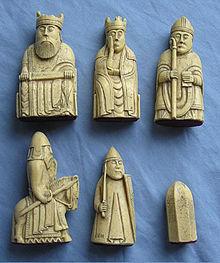
ORIGIN
Origin[edit]
| a | b | c | d | e | f | g | h | ||
| 8 | 8 | ||||||||
| 7 | 7 | ||||||||
| 6 | 6 | ||||||||
| 5 | 5 | ||||||||
| 4 | 4 | ||||||||
| 3 | 3 | ||||||||
| 2 | 2 | ||||||||
| 1 | 1 | ||||||||
| a | b | c | d | e | f | g | h |
| This example uses algebraic notation. |
Precursors to chess originated in India during the Gupta Empire.[3] There, its early form in the 6th century was known as chaturaṅga, which translates as "four divisions (of the military)": infantry, cavalry, elephantry, and chariotry. These forms are represented by the pieces that would evolve into the modern pawn, knight, bishop, and rook, respectively.[4] According to chess historians Gerhard Josten and Isaak Linder, "the early beginnings" of chess can be traced back to the Kushan Empire in Ancient Afghanistan, circa 50 BCE–200 CE.[5][6]
Chess was introduced to Persia from India and became a part of the princely or courtly education of Persian nobility.[7] In Sassanid Persia around 600 the name became chatrang, which subsequently evolved to shatranj, due to Arab Muslims' lack of ch and ng native sounds,[8] and the rules were developed further. Players started calling "Shāh!" (Persian for "King!") when attacking the opponent's king, and "Shāh Māt!" (Persian for "the king is helpless" – seecheckmate) when the king was attacked and could not escape from attack. These exclamations persisted in chess as it traveled to other lands.
The game was taken up by the Muslim world after the Islamic conquest of Persia, with the pieces largely keeping their Persian names. The Moors of North Africa rendered Persian "shatranj" as shaṭerej, which gave rise to the Spanish acedrex, axedrez and ajedrez; in Portuguese it becamexadrez, and in Greek zatrikion, but in the rest of Europe it was replaced by versions of the Persian shāh ("king"). Thus, the game came to be called ludus scacchorum or scacc(h)i in Latin, scacchi in Italian, escacs in Catalan, échecs in French (Old French eschecs); schaken in Dutch, Schach in German, szachy in Polish, šahs in Latvian, skak in Danish, sjakk inNorwegian, schack in Swedish, šakki in Finnish, šah in South Slavic languages, sakk in Hungarian and şah in Romanian; there are two theories about why this change happened:
- From the exclamation "check" or "checkmate" as it was pronounced in various languages.
- From the first chessmen known of in Western Europe (except Iberia and Greece) being ornamental chess kings brought in as curios by Muslim traders.
The Mongols call the game shatar, and in Ethiopia it is called senterej, both evidently derived from shatranj.
Chess spread directly from the Middle East to Russia, where chess became known as шахматы (shakhmaty, literally "checkmates", a plurale tantum).
The game reached Western Europe and Russia by at least three routes, the earliest being in the 9th century. By the year 1000 it had spread throughout Europe.[9] Introduced into the Iberian Peninsula by the Moors in the 10th century, it was described in a famous 13th-century manuscript covering shatranj, backgammon and dice named the Libro de los juegos.
Chess spread throughout the world and many variants of the game soon began taking shape.[10] Buddhist pilgrims, Silk Road traders and others carried it to the Far East where it was transformed and assimilated into a game often played on the intersection of the lines of the board rather than within the squares.[10][11] Chaturanga reached Europe through Persia, the Byzantine empire and the expanding Arabian empire.[12] Muslims carried chess to North Africa, Sicily, and Iberia by the 10th century.[10]
The game was developed extensively in Europe. By the late 15th century, it had survived a series of prohibitions andChristian Church sanctions to almost take the shape of the modern game.[13] Modern history saw reliable reference works,[14] competitive chess tournaments,[15] and exciting new variants. These factors added to the game's popularity,[15]further bolstered by reliable timing mechanisms (first introduced in 1861), effective rules,[15] and charismatic players
